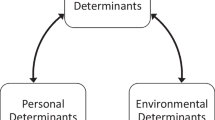Abstract
The aim of this study is to analyze the impact of digital work design on social relationship skill through Digital-Mediated Communication (DMC) for learning methods in the digital era. This study presents how to improve social relationship skill for university lectures. Data were collected by using questionnaire techniques with SmartPLS as the analysis tool. The result found that all hypotheses are confirmed. The Implementation of DMC not only improves social relationship skill but also improve the virtual empathy that rarely appear during digital interaction. The model of social relationship skill improvement through DMC and digital work design can be used by researchers and practitioners to study and achieve the future in various organizations.
Access this chapter
Tax calculation will be finalised at checkout
Purchases are for personal use only
Similar content being viewed by others
References
Prasad, S., Shankar, R., Gupta, R., Roy, S.: A TISM modeling of critical success factors of blockchain based cloud services. J. Adv. Manag. Res. 15, 434–456 (2018). https://doi.org/10.1108/JAMR-03-2018-0027
Wiśniewska-Paź, B.: Emotional intelligence vs. digital intelligence in the face of virtual reality. New challenges for education for safety: the need for “new” communication and adaptation competencies. Cult. e Stud. Del Soc. 3, 167–176 (2018)
Luppicini, R.: Review of computer mediated communication research for education. Instr. Sci. 35, 141–185 (2007)
Gibbs, M.: How is new technology changing job design? Institute for the Study of Labor (IZA), Bonn Germany (2017). https://doi.org/10.15185/izawol.344
Richter, A., Heinrich, P., Stocker, A., Schwabe, G.: Digital work design: the interplay of human and computer in future work practices as an interdisciplinary (grand) challenge. Bus. Inf. Syst. Eng. 60(3), 259–264 (2018). https://doi.org/10.1007/s12599-018-0534-4
Yee, N.: The Proteus paradox: How online games and virtual worlds change us - and how they don’t. Yale University Press, New Haven, CT (2014)
Dery, K., MacCormick, J.: Managing mobile technology: the shift from mobility to connectivity. MIS Q. Exec. 11, 159–173 (2012)
Tarafdar, M., D’Arcy, J., Turel, O., Gupta, A.: The dark side of information technology, MIT Sloan Manag. Rev. (2014) 61–70
Lau, W.W.F.: Effects of social media usage and social media multitasking on the academic performance of university students. Comput. Hum. Behav. 68, 286–291 (2017). https://doi.org/10.1016/j.chb.2016.11.043
Ou, C.X., Sia, C.L., Hui, C.K.: Computer-mediated communication and social networking tools at work. Inf. Technol. People 26, 172–190 (2013)
Sharma, D.: Resistance to human resouce information systems (HRIS) - problem recognition, diagnosis and positive intervention: a study on employee behavior and change management. Indian J. Appl. Res. 90, 99–104 (2013). https://doi.org/10.15373/2249555X/JAN2013/39
Buckley, P., Minette, K., Joy, D., Michaels, J.: The use of an automated employment recruiting and screening system for temporary professional employees: a case study. Hum. Resour. Manage. 43, 233–241 (2006). https://doi.org/10.1002/hrm.20017
Kane, G.C.: Enterprise social media: current capabilities and future possibilities. MIS Q. Exec. 14, 1–16 (2015)
Rushkoff, D.: Present Shock: When Everything Happens Now. Penguin Group, New York, US (2013)
Baston, C.D.: The Social Neuroscience of Empathy. MIT Press., Cambridge, Cambridge (2009)
Kaloudis, A., et al.: How Universities Contribute to Innovation: A Literature Review-based Analysis (2019)
Caplan, S.E., Turner, J.S.: Bringing theory to research on computer-mediated comforting communication. Comput. Hum. Behav. 23, 985–998 (2007). https://doi.org/10.1016/j.chb.2005.08.003
Hancock, J.T., Naaman, M., Levy, K.: AI-mediated communication: definition, research agenda, and ethical considerations. J. Comput. Commun. 25, 1–12 (2020). https://doi.org/10.1093/jcmc/zmz022
Merdian, H.L., Reid, S.L.: E-professionalism: usage of social network sites by psychological professionals in training. Psychol. Aotearoa. 5, 28–33 (2013)
Iksan, Z.H., et al.: Communication skills among university students. Proc. Soc. Behav. Sci. 59, 71–76 (2012). https://doi.org/10.1016/j.sbspro.2012.09.247
Carmeli, A., Gittell, J.H.: High-quality relationships, psychological safety, and learning from failures in work organizations. J. Organ. Behav. 30, 709–729 (2009). https://doi.org/10.1002/job
Hair, J.F., Hult, G.T.M., Ringle, C.M., Sarstedt, M.: A Primer on Partial Least Squares Structural Equation Modeling (PLS-SEM), 2nd edn SAGE Publication, Los Angeles (2017)
Diamantopoulos, A., Riefler, P., Roth, K.: The problem of measurement model misspecification in behavioral and organizational research and some recommended solutions. J. Appl. Psychol. 90, 710–730 (2005)
Kano, Y., Morita, J.: Factors influencing empathic behaviors for virtual agents. In: Proc. 7th Int. Conf. Human-Agent Interact. - HAI ’19, pp. 236–238 (2019). https://doi.org/10.1145/3349537.3352777
Author information
Authors and Affiliations
Corresponding author
Editor information
Editors and Affiliations
Rights and permissions
Copyright information
© 2021 The Author(s), under exclusive license to Springer Nature Switzerland AG
About this paper
Cite this paper
Adhiatma, A., Hasanah, U.K. (2021). Building Social Relationship Skill in Digital Work Design. In: Barolli, L., Yim, K., Enokido, T. (eds) Complex, Intelligent and Software Intensive Systems. CISIS 2021. Lecture Notes in Networks and Systems, vol 278. Springer, Cham. https://doi.org/10.1007/978-3-030-79725-6_26
Download citation
DOI: https://doi.org/10.1007/978-3-030-79725-6_26
Published:
Publisher Name: Springer, Cham
Print ISBN: 978-3-030-79724-9
Online ISBN: 978-3-030-79725-6
eBook Packages: Intelligent Technologies and RoboticsIntelligent Technologies and Robotics (R0)




